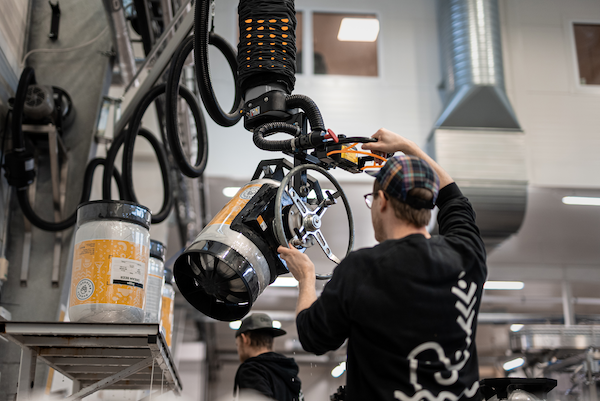By Matilda Odell, Content Creation Specialist at TAWI
Food production facilities operate in a highly competitive market, with strict regulations to comply with at the state, federal, and international levels. These facilities face numerous external disruptions, which lower their profitability.
Furthermore, they grapple with unpredictable consumer demands, ergonomic problems, supply chain challenges, and pressure to adopt sustainable production techniques. This is why companies in the food production sector should continuously innovate. At least if they want to maintain a competitive advantage on the market.
Innovation in the food production line cuts across:
- Proper asset management
- Integration of digital technologies
- Utilizing appropriate lifting solutions
- Embracing sustainable production and packaging solutions
- Data analysis and machine learning
Transforming food production lines is a challenging task for every manager so here are some useful tips on how to stay on top of the game in the industry.
#1: Utilize appropriate lifting solutions
Food production lines involve multiple processes that require frequent lifting, loading, and unloading of raw or finished products. These repetitive tasks demand the utmost attention and accuracy from line workers. However, manual lifting, loading, and unloading expose workers to various ergonomic injuries and accidents.
Utilizing appropriate lifting solutions can revolutionize operations in your food production line. These solutions reduce exposure to workplace hazards that exacerbate ergonomic injuries.
Different lifting solutions exist depending on the type and nature of loads on the production line, available working space, safety requirements, and the degree of movement across the production floor. Common lifting solutions include:
- Hoists
- Gantry cranes
- Boom lifts
- Pallet lifts
- Vertical conveyors
- Mobile vacuum lifters
Efficient loading and unloading solutions reduce manual interventions in routine production schedules and protect workers from musculoskeletal injuries caused by overexertion when lifting, lowering, or carrying heavy loads.
In addition to reducing workplace injuries and promoting worker safety, these solutions can also enhance productivity by ensuring a faster and more consistent flow of goods across the production line. Equipment such as conveyor belts and pallet lifts can transport large and heavy quantities of products at once, allowing for more efficient and streamlined operations.
#2: Invest in data-driven equipment maintenance
Regular maintenance reduces the probability of equipment failures, which impact reliability, availability, and safety. Failure of lifting solutions, for example, means workers have to manually lift and transport raw materials and products through the production line. This translates to reduced productivity and can increase the risk of contamination.
Some equipment failures cause undesirable breakdowns, rendering the entire production line unoperational. As a result, companies cannot effectively meet consumer demands.
A data-driven maintenance strategy ensures all assets in a food production facility receive accurate and timely corrective or preventive measures to avert downtime and breakdowns. Companies can focus on perfecting their preventive maintenance schedules and determining maintenance timelines based on equipment utilization rates, age, or frequency of failure.
Companies can step up equipment maintenance measures with predictive maintenance. This maintenance strategy utilizes sensors fitted on lifting equipment to monitor their real-time performances. These sensors can detect the slightest changes in lift equipment operating conditions and alert workers of impending failures.
Long-term condition-monitoring data is used to develop predictive algorithms to detect and rectify potential failures before they cause breakdowns or lifting equipment failures.
#3: Adopt sustainable production solutions
Food production companies aim to increase profitability by eliminating low-value processes and minimizing waste. To achieve this, they allocate budgets for power bills, packaging solutions, waste management, and research and development. However, embracing sustainable production solutions can further transform food production lines.
Available solutions include:
- Renewable energy — installing standalone renewable energy solutions like solar panels or wind turbines provides cheap and reliable power to run equipment on the food production line while reducing greenhouse gas emissions.
- Sustainable packaging and logistics — to reduce environmental pollution, food production facilities can use biodegradable, compostable, and recyclable packaging materials. Ensure your supply chain is also sustainable and eco-friendly.
- Recycling and waste reduction — recycling can reduce the strain on natural resources. Companies can improve production processes to reduce waste, such as spillage when packaging finished products. Moreover, they can convert process waste into animal feed and diversify their portfolio for higher revenues.
#4: Use data analytics and machine learning
Data analytics and machine learning are advanced food processing solutions that provide invaluable insights for streamlining routine operations and enhancing the quality of finished products. By utilizing data from sensors on production equipment, historical production records, and emerging market trends, they offer accurate and affordable food processing operations.
One major benefit of machine learning and analytics is their ability to monitor product quality. Sensors can track products as they move across the production line and identify potential quality issues. Workers can then perform corrective actions to ensure products meet the desired quality requirements and minimize waste.
In addition, analytics and machine learning are beneficial for inventory optimization and demand forecasting. Companies can adjust production levels based on available inventories and estimate how prevailing supply chain concerns impact routine production.
Food production facilities can use analytics to optimize fleet routing for timely deliveries. Other benefits of analytics and machine learning in a food production line are:
- Optimizing energy utilization
- Improving equipment maintenance
- Labor planning
Parting thoughts
While transforming the food production line takes time and effort, companies should not end with revamping systems and production equipment.
They should train employees and educate them on the benefits of new food production solutions, continuously monitor the performances of these solutions, and establish a continuous improvement program. That helps with achieving substantial returns on investment, maximizing productivity, and remaining competitive and compliant.
